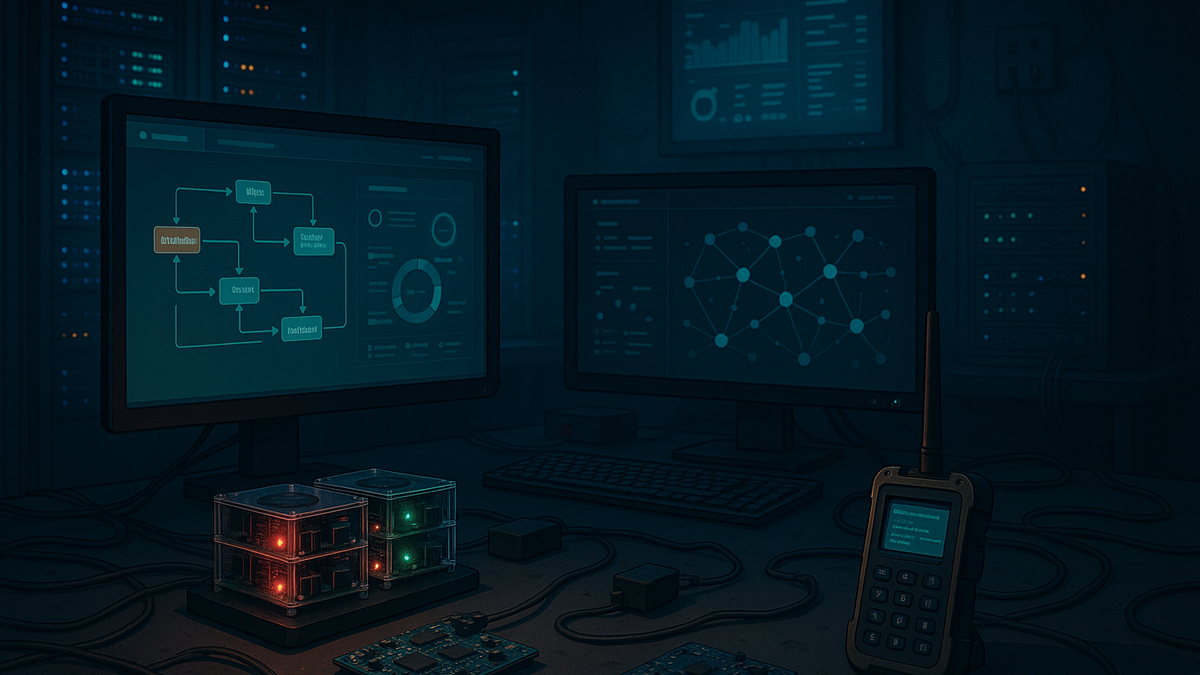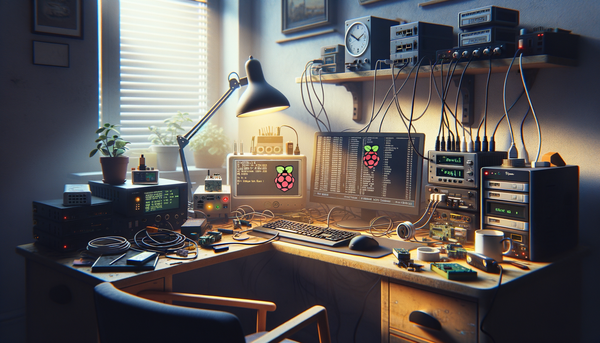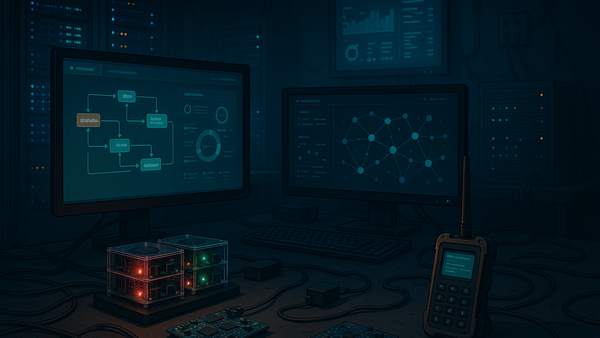What Is a Homelab? Definition, Purpose, and Beginner’s Guide to Building Your Own
Discover what a home lab is, its purpose, benefits, and beginner-friendly setups. Learn how to start, plan, and optimize your own home lab for learning, experimentation, and self-hosting.

Key Takeaways
- A home lab is a personal technology environment used for experimentation, learning, and self-hosting.
- Home labs provide hands-on experience without risk to production systems.
- They support skill development, career advancement, and creative exploration.
- Popular home lab use cases include networking, cybersecurity, software testing, and self-hosting services.
- Budget-friendly options include repurposed hardware and virtualization solutions.
- Proper planning, location, cooling, and noise management improve home lab usability.
- The home lab community offers extensive resources for beginners and professionals alike.
Table of Contents
- Home Lab Defined
- Purpose of a Home Lab for Learning
- Key Benefits of a Home Lab
- Common Use Cases
- Home Lab Ideas for Beginners
- Planning Your Home Lab
- Budget-Friendly Home Labs
- Types of Home Lab Setups
- Choosing a Home Lab Location
- Managing Noise & Temperature
- Next Steps & Resources
- Conclusion
1. Home Lab Defined
A home lab refers to any personal technology environment set up at home, often involving servers, computers, or single-board devices, used for experimentation, testing, and learning. Unlike production environments where mistakes can be costly and disruptive, a home lab offers a safe playground where you can break things, fix them, and learn through the process without consequences.
The concept of home labs has evolved significantly over the past decade. With hardware costs decreasing and the rise of powerful single-board computers like Raspberry Pi, creating a personal technology testing environment has become accessible to nearly everyone—not just IT professionals.
For more information, visit Linux Handbook or watch this video.
2. Purpose of a Home Lab for Learning
The primary reasons people build home labs include:
Learning & Skill Development
A home lab for learning provides hands-on experience with technologies you might not access otherwise. Users can practice networking configurations, server administration, programming, virtualization, and cybersecurity techniques in a realistic environment. This practical experience often leads to deeper understanding than theoretical study alone.
Many IT professionals maintain home labs to stay current with emerging technologies or to prepare for certifications. The ability to experiment without fear of breaking production systems accelerates the learning process substantially.
Learn more at 360 Security Services and this video.
Experimentation
Home labs for experimentation allow you to test new operating systems, software stacks, or configurations before deploying them in production environments. This testing ground lets you explore technology without the pressure of immediate success.
You can build complex systems, intentionally break them to study failure modes, or test migrations between platforms—all valuable experiences that would be too risky in real-world settings.
See more on Linux Handbook and watch this video.
Self-Hosting
Many enthusiasts build home labs for self-hosting services they'd otherwise pay for in the cloud. Common self-hosted applications include:
- Media servers (Plex, Jellyfin)
- Personal cloud storage (Nextcloud, ownCloud)
- Home automation hubs (Home Assistant)
- VPN servers
- Git repositories
- Website hosting
Self-hosting gives you complete control over your data and services while potentially saving money long-term compared to subscription services.
Discover more at Linux Handbook and YouTube.
Career Advancement
A well-maintained home lab demonstrates initiative, technical aptitude, and problem-solving skills to potential employers. The projects you build can serve as portfolio pieces that showcase your capabilities far better than certifications alone.
This is why many IT professionals build home labs—they provide both skill development and tangible evidence of those skills.
3. Key Benefits of a Home Lab
The advantages of maintaining a home lab extend beyond just learning:
Hands-on Experience
Working directly with hardware and software creates a deeper understanding than theoretical knowledge alone. You'll encounter and solve real-world problems, developing troubleshooting skills that transfer directly to professional environments.
This experiential learning often reveals subtle aspects of technology that documentation might miss or simplify.
Further reading: 360 Security Services
Safe Test Environment
A home lab provides a consequence-free zone where mistakes become learning opportunities rather than disasters. You can:
- Test destructive updates
- Experiment with configuration changes
- Practice recovery procedures
- Try new automation scripts
This safety net encourages the kind of exploration that leads to mastery.
Learn more at Linux Handbook.
Cost Savings
While there's an initial investment, home labs can save money over time by:
- Eliminating recurring cloud service fees
- Allowing reuse of older hardware
- Reducing electricity costs compared to cloud computing (for certain workloads)
- Providing training that would otherwise require expensive courses
Many home labs start with repurposed equipment, minimizing upfront costs while maximizing learning value.
See details at Linux Handbook.
Professional & Hobbyist Advantages
For professionals, home labs offer a competitive edge through continuous skill development and portfolio building. For hobbyists, they provide a creative outlet and the satisfaction of building and maintaining personal infrastructure.
Both groups benefit from the self-reliance that comes with understanding how technology systems work from the ground up.
Learn more at 360 Security Services.
4. Common Use Cases
Wondering what you can do with a home lab? The possibilities are nearly endless:
Networking Labs
- Configure and test virtual LANs (VLANs)
- Set up and manage firewalls
- Experiment with routing protocols
- Practice network segmentation
- Build VPN tunnels between networks
These skills are valuable for network administrators and security professionals alike.
Explore Linux Handbook.
Cybersecurity Practice
- Set up honeypots to study attack patterns
- Configure intrusion detection systems
- Practice penetration testing techniques
- Build security monitoring solutions
- Test vulnerability scanning tools
A security-focused home lab lets you explore offensive and defensive techniques safely.
Check out this video.
Software Stack Testing
- Deploy web servers, databases, and application servers
- Test containerization with Docker or Kubernetes
- Build development, testing, and production environments
- Practice continuous integration/continuous deployment (CI/CD)
- Experiment with microservices architecture
Software developers and DevOps engineers particularly benefit from these environments.
Watch this video.
Self-Hosting Services
- Media servers for personal content streaming
- Private cloud storage to replace Dropbox/Google Drive
- Personal VPN for secure remote access
- Password managers (Bitwarden)
- Smart home hubs and automation servers
- Personal wikis, note-taking systems, or knowledge bases
Self-hosting reduces dependence on third-party services while enhancing privacy.
Learn more at Linux Handbook.
Practical Projects
- Host your personal or professional website
- Build a Network Attached Storage (NAS) system
- Create a small-scale Kubernetes cluster
- Set up a dedicated game server
- Develop an IoT hub for smart home devices
- Configure a personal email server
These projects provide both learning opportunities and practical benefits.
Watch this tutorial.
5. Home Lab Ideas for Beginners
If you're just starting, here are some beginner-friendly home lab ideas:
Raspberry Pi Projects
- Set up a web server to host a simple website
- Install Pi-hole for network-wide ad blocking
- Create a personal Git server for version control
- Build a basic NAS for file sharing
- Configure a VPN server for secure remote access
Raspberry Pis provide an affordable entry point with low power consumption.
Virtualization on Existing Hardware
- Install VirtualBox or KVM on your current PC
- Create multiple virtual machines to simulate a network
- Practice setting up different operating systems
- Build a virtual security lab with vulnerable machines
- Test server configurations without additional hardware
Virtualization lets you maximize limited resources while learning essential skills.
Mini Clusters
- Link two Raspberry Pis for a basic computing cluster
- Experiment with load balancing between nodes
- Learn distributed computing concepts
- Practice high-availability configurations
- Build redundant storage solutions
Clustering teaches important enterprise concepts on a small scale.
Repurposed Hardware
- Convert an old desktop into a file server
- Use a retired laptop as a monitoring station
- Build a media server from outdated equipment
- Create a dedicated firewall from an old PC
- Set up a print server to share printers on your network
Repurposing extends the life of electronics while providing valuable services.
More ideas at Linux Handbook.
6. Planning Your Home Lab
Before purchasing equipment, carefully consider your home lab goals:
Define Purpose
Clearly specify what you want to accomplish:
- Are you primarily focused on learning specific technologies?
- Do you need a platform for hosting services?
- Will you use it for testing before deploying to production?
Your purpose determines the appropriate scale and components for your lab.
Watch this guide: Video.
Home Lab Basics
Every lab needs these core components:
Compute
- CPU: Consider cores and virtualization support
- RAM: Crucial for running multiple VMs or containers
- Hardware compatibility with your chosen hypervisor
Storage
- HDD vs. SSD tradeoffs (speed vs. capacity vs. cost)
- RAID configurations for data protection
- Backup solutions to prevent data loss
Networking
- Switches (managed vs. unmanaged)
- Routers or firewalls
- Cabling (Cat6 or better recommended)
- Network interface cards (NICs)
Understanding these fundamentals helps you make informed decisions.
Home Lab Planning Process
Follow these steps for successful planning:
- Set a realistic budget
- Create a timeline for implementation
- Identify necessary skills and learning resources
- Plan for future expansion
- Consider power and cooling requirements
- Document your design before purchasing
Proper planning prevents costly mistakes and ensures your lab meets your needs.
See detailed explanation: Video.
7. Budget-Friendly Home Labs
Building a home lab doesn't require breaking the bank:
Second-hand Enterprise Gear
- Former data center servers available on eBay and specialized marketplaces
- Enterprise networking equipment at fraction of new cost
- Decommissioned workstations from businesses
- Watch for corporate IT refreshes in your area
Caution: Check power consumption before purchasing older enterprise gear.
More info: Linux Handbook.
Repurpose Old Computers
- Convert old desktops into servers
- Use retired laptops as management stations
- Repurpose gaming PCs as virtualization hosts
- Stack mini PCs for small clusters
Even systems 5-10 years old can make suitable lab equipment.
Open-Source Software Alternatives
- Linux distributions instead of Windows Server
- Free hypervisors like Proxmox or XCP-ng
- Open-source monitoring tools like Grafana and Prometheus
- Community editions of enterprise software
Open-source solutions provide enterprise-like functionality without licensing fees.
Virtualization for Efficiency
- Run multiple virtual machines on a single host
- Use containers for even greater density
- Create virtual networks without physical switches
- Simulate complex environments on limited hardware
Virtualization stretches your resources and more closely mimics modern data centers.
Watch more at YouTube.
8. Types of Home Lab Setups
Home labs generally fall into several categories:
Beginner Home Lab Setups
Perfect for those just starting their home lab journey:
- Single desktop repurposed as a server
- Raspberry Pi or similar single-board computer
- Old laptop running virtualization software
- Consumer NAS device with added functionality
These setups require minimal investment while providing valuable learning opportunities.
Learn more at Linux Handbook.
Dedicated Rack Setups
For advanced users with space and budget:
- Rackmount servers in a small rack enclosure
- Patch panels and cable management
- Rack-mounted UPS for power protection
- Proper networking equipment
- Dedicated cooling solutions
This approach most closely resembles enterprise environments.
Desktop Cluster Arrangements
Balancing power and practicality:
- Multiple small form-factor PCs
- Custom-built mini servers
- Tower servers in a designated area
- Desktop workstations connected as nodes
These setups offer good computing power without specialized racks.
Pi Farms
Economical and energy-efficient:
- Multiple Raspberry Pis or similar SBCs
- Specialized Pi racks or custom stacking solutions
- Power distribution through USB hubs
- Network through small switches
- Low power consumption suitable for 24/7 operation
Perfect for learning clustering and distributed systems on a budget.
Virtual vs. Physical Home Labs
Each approach has distinct advantages:
Virtual Home Labs:
- Lower initial cost
- Smaller physical footprint
- Easier to back up and restore
- Simple to reconfigure quickly
- Lower power consumption
Physical Home Labs:
- Direct hardware experience
- No resource competition between systems
- More realistic enterprise experience
- Better performance for certain workloads
- Closer to real-world troubleshooting scenarios
Many enthusiasts eventually adopt a hybrid approach, using both virtual and physical components.
More details at Linux Handbook.
9. Choosing a Home Lab Location
The right location balances convenience, environmental factors, and household harmony:
Space Requirements
Assess your needs based on your equipment:
- Desktop setups need desk or shelf space
- Rack systems require dedicated floor space
- Consider access for maintenance and upgrades
- Allow room for future expansion
Measure twice before committing to hardware that might not fit.
Watch helpful advice at YouTube.
Home Lab in Small Apartment
Limited space requires creative solutions:
- Wall-mounted mini racks
- Under-desk shelving units
- Closet installations with ventilation
- Vertical stacking systems
- Mini-ITX or SFF builds to minimize footprint
Even a studio apartment can house a functional lab with proper planning.
Infrastructure Considerations
Beyond the equipment itself, consider:
- Proximity to electrical outlets
- Network cabling pathways
- Distance to your router/internet connection
- Sound insulation for noisy equipment
- Temperature management in enclosed spaces
These factors significantly impact both functionality and livability.
10. Managing Noise & Temperature
Keeping your lab comfortable for both equipment and humans:
Quiet Home Lab Setup
For labs in living spaces:
- Choose fanless or low-RPM cooling solutions
- Select SSD over HDD where possible
- Use sound-dampening cases and cabinets
- Consider passively cooled components
- Schedule intensive tasks during times you're away
Modern components often run quieter than older enterprise gear.
Learn more at Linux Handbook.
Home Lab Noise Reduction
When equipment is inherently loud:
- Install rubber mounts for fans and drives
- Add acoustic foam in server cabinets
- Place equipment on vibration-absorbing pads
- Use fan controllers to reduce speed when full power isn't needed
- Consider water cooling for high-performance systems
Small modifications can significantly reduce perceived noise.
Home Lab Cooling Solutions
Prevent overheating with proper thermal management:
- Ensure adequate airflow around all equipment
- Monitor temperatures with software or dedicated sensors
- Add supplemental fans for hot spots
- Consider room air conditioning for larger setups
- Maintain dust-free equipment through regular cleaning
Good cooling extends equipment life and prevents performance throttling.
11. Next Steps & Resources
Ready to start your home lab journey?
Review Why Build a Home Lab
Remember that a home lab provides:
- A safe space for hands-on technology learning
- Platform for testing before production deployment
- Opportunity to build portfolio-worthy projects
- Infrastructure for self-hosted services
- Playground for technological creativity
Your motivation determines your ideal starting point.
Community Resources
Connect with others on the same journey:
- Reddit r/homelab community
- ServeTheHome forums
- Discord servers dedicated to home labs
- Local maker spaces and tech meetups
- Professional IT organizations
Learning from others' experiences accelerates your progress.
Educational Content
Deepen your knowledge with these sources:
- YouTube channels dedicated to homelabbing
- Linux Handbook and other technical blogs
- Free online courses on virtualization and networking
- Vendor documentation for specific technologies
- Books on system administration and infrastructure
Continuous learning keeps your lab relevant and exciting.
Personal Planning Document
Create your roadmap:
- Document your specific goals
- List equipment you already have
- Research components you need
- Set a realistic budget and timeline
- Plan your first three projects in detail
A structured approach leads to better results.
See resources:
YouTube 1
YouTube 2
Linux Handbook
Conclusion
A home lab is more than just a collection of hardware—it's a powerful platform for learning, experimentation, and self-hosting that adapts to your needs and interests. Whether you start with a single Raspberry Pi or build an elaborate rack of servers, the skills you gain from creating and maintaining a home lab have real-world value for both personal and professional growth.
The most important step is simply to begin. Start with what you have, focus on what you want to learn, and let your lab evolve naturally as your skills and interests expand. The home lab community is welcoming and supportive, with endless resources to help at every stage of your journey.
Start planning your home lab today. Your future self will thank you for the investment in your technical education and digital self-sufficiency.




